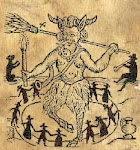 In the last class we talked about the use of children, babies or the unborn in terms of the devil and cinema. This anxiety about children and Satanism, or evil in general, affected society’s fear for children’s safety from the occult. On a related note I wondered what role women might play in terms of Satan and popular movies, and if their role or depiction could be boiled down to affects on society or cinematically.
In the last class we talked about the use of children, babies or the unborn in terms of the devil and cinema. This anxiety about children and Satanism, or evil in general, affected society’s fear for children’s safety from the occult. On a related note I wondered what role women might play in terms of Satan and popular movies, and if their role or depiction could be boiled down to affects on society or cinematically.While as a film major this may be embarrassing to admit, but the first thing that came to my mind was the semi-popular, critically unclaimed 2000 film starring (the possibly dead, certainly forgotten) Brendan Fraser and more significantly (at least to this) Elizabeth Hurley as the Devil. While the latest version might be little more than pure entertainment the original Bedazzled was a 1967 Stanley Donen film, and while the concept of the devil appearing before a down-on-his-luck guy and purposefully messing up his wish granting was the same, the devil was in fact played by a man; possibly confused with Raquel Welch who was acting the part of Lust. Both of these stories were based off the Faust legend, which is “the story of the German necromancer and astrologer who sold his soul to the Devil in exchange for knowledge and power" (source: http://www.mystical-www.co.uk/faust.htm)
While the Faust legend is extremely significant seeing as it influences literature, films, and art dealing with the occult, it deviates just a bit from my original topic—women playing the devil. I’ll offer another seemingly quite different example that will actually tie in with the point you may have doubted I had. Like a lot of the occult cinema, Girlfriend from Hell, was labeled and distributed as a B-Movie. Because of the environment (high school) and main situation (house party) the movie is also one of the teen-romp genres but the nerdy girl attending the party has been taken over and made over by the devil. A fellow high school girl is of God’s power and there in lies the heavenly catfight. (source: http://en.wikipedia.org/wiki/Girlfriend_from_Hell)
What these two movies (and even Raquel Welch’s character in the original Bedazzle) illustrate in relation to the woman’s role as the devil is that the woman is merely used as a tool of seduction; seduction both in the literal sense, but mainly of the soul/faith sense. Putting the devil in an hourglass package only physically embodies the idea of temptation or the attraction that evil has on certain people (like the down-on-his-luck Brendan Fraser or the nerdy girl at high school). While I can’t really explain why women aren’t depicted as the devil more (I don’t mean that in a negative way) I can only assume that part of it is contributed to the fact that the Devil has largely, in all forms of culture, been depicted as a male, and this possibly stems from the fact that men have been doing the majority of these depictions.
Other Things to Check Out / Consider:
- Since we discussed the color use in Danger’s films, a more blatant yet significant use of color appears in Elizabeth Hurley’s portrayal of the devil in terms of her wardrobe and in the wishes she grants for the man.
- This New York Times article on the general portrayal of the Devil in media, mainly focuses on male actors and therefore if you want the gender-equal discussion maybe take a look at this…I feel like the male portrayal of the devil centers more on the sense of “power” (ala Al Pacino in the Devil’s Advocate) rather than the “attraction” or “seduction” aspect that woman tend to embody.
-also IMDB has an entry for all the movies mentioned in here…
Hope this isn’t too far off topic, just thought it was an interesting thing to consider; the idea of gender in terms of the cinematic representation of the Devil. I’m sure there are more examples as well; a more extensive search or prior knowledge and one could illuminate me further.

1 comment:
Oh, yes, gender is really at the root of many representations of occult evil, most notably in figures of witches or sorceresses...the vampire genre contains this as well. And if you consider the "evil" at the root of a zombie film like 28 Days Later, the key is in the title: it is all about women, blood, and rage.
Nicholas Shreck discusses the significance of gender in a number of films in The Satanic Screen.
Post a Comment